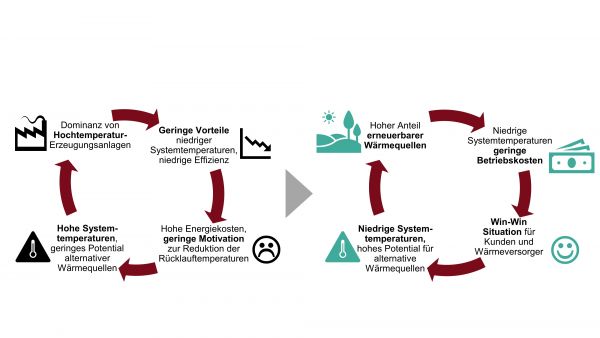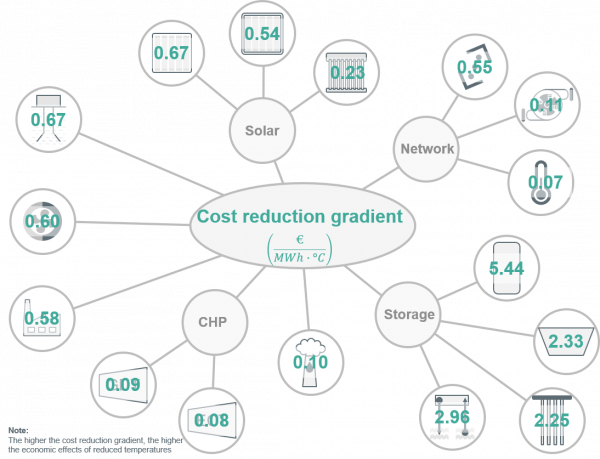IEA-DHC Annex TS2: Implementation of Low Temperature District Heating Systems
Short Description
Initial situation/motivation
Changing market conditions and the need to avoid CO2 emissions make it necessary to rethink the current generation structures in heat supply. Since renewable fuels are increasingly used for the industrial and mobility sectors, alternative sources such as solar and geothermal energy, ambient heat and waste heat as well as heat pumps will play an increasingly important role in the heat supply sector. However, their potential and economic efficiency is highest at low system temperatures, but current district heating networks are dominated by high temperatures.
Accordingly, besides the installation of new low-temperature systems (so-called 4th generation district heating networks (4GDH)), the reduction of system temperatures in existing systems is of crucial importance for sustainable decarbonisation.
Objectives and methodology
The objective of the IEA DHC Annex TS2 is to facilitate the implementation or transformation of district heating networks towards the 4th generation. For this purpose, the Annex TS2 forms a platform that creates the prerequisites for implementation with international experts. In this context, the following 5 topics were addressed:
- technology: necessary technological solutions for 4GDH implementation
- system functions: with a focus on the efficient functioning of the technologies
- demonstration: analysis and evaluation of demonstration systems
- competitiveness: evaluation and investigation of efficient business models for 4GDH
- dissemination and handbook: collection of results and preparation of a handbook.
Within Annex TS2, an Austrian consortium consisting of AIT, AEE Intec, TU Wien and Austroflex participated and contributed mainly in the area of system analysis (task lead: AIT) and through various case studies.
Results and conclusions
In new buildings, low-temperature district heating is easier to realise than assumed by many actors, but suitable processes have to be implemented and a certain foresight is needed. In existing networks, however, the prevailing high flow temperatures represent a lock-in effect: For fossil fuels (and biomass), the economic advantages of low system temperatures are low, resulting in little motivation to reduce the temperature level. Accordingly, there is a lack of concrete incentives to initiate measures to reduce return temperatures, which in turn results in a reduced potential of alternative heat sources and stabilises the dominance of high-temperature generators.
Project Images
Terms of use: The pictures listed underneath the header “Project Pictures” originate from the projects in the frame of the programmes City of Tomorrow, Building of Tomorrow and the IEA Research Cooperation. They may be used credited for non-commercial purposes under the Creative Commons License Attribution-NonCommercial (CC BY-NC).
Participants
Austria, Denmark, Germany, Norway, Sweden (Operating Agent)
Contact Address
Project leader
Roman Geyer
c/o Ralf-Roman Schmidt
AIT Austrian Institute of Technology GmbH
Giefinggasse 6
1210 Wien
E-Mail: Roman.Geyer@ait.ac.at
Project partners
Harald Schrammel
AEE - Institut für Nachhaltige Technologien
Feldgasse 19
8200 Gleisdorf
E-Mail: h.schrammel@aee.at
Karl Ponweiser
TU Wien - Institut für Energietechnik und Thermodynamik
Getreidemarkt 9/302
1060 Wien
E-Mail: karl.ponweiser@tuwien.ac.at
Christian Engel
Austroflex Rohr-Isoliersysteme GmbH
E-Mail: christian.engel@austroflex.com



